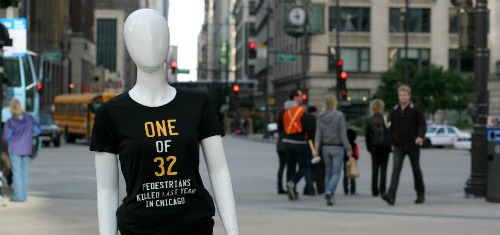
Mannequin on Chicago’s Wacker Drive part of that city’s pedestrian safety campaign. Photo from CDOT’s Facebook page.
 Mannequins stand up for safety along Wacker Drive [The Chicago Tribune]
Mannequins stand up for safety along Wacker Drive [The Chicago Tribune]
Mannequins representing dead pedestrians were placed along Wacker Drive downtown on Tuesday to focus public attention on fatal crashes in Chicago involving vehicles and people on foot, officials said.
“You’ll notice that some of it is sort of hard-hitting, some of it may even be a little bit shocking,” said CDOT Commissioner Gabe Klein. “But we want to remind people that when you are frustrated behind the wheel, these are real people and real lives we are talking about here. Please take that into consideration when you are driving, when you are riding your bike and when you are walking to look out for those around you.”
What works in cities: Why placemaking requires passion even more than big budgets [YongeStreet]
Before Detroit’s Campus Martius Park opened in 2004, many of the historic buildings around it had emptied. Major department stores were vacant or torn down.
To turn it around, the mayor’s office established a task force that studied the best public spaces in the world and quizzed the locals on how they would use a new park. After a $20-million investment, the park started buzzing year-round with music, a bistro, and ice skating under colourful lights and a giant Christmas tree. The park has since attracted several new corporate headquarters, new condos and a whopping one million park visitors each year.
Are we reaching ‘peak car’? [The Globe and Mail]
Experts say our love affair with the automobile is ending, and that could change much more than how we get around – it presents both an opportunity and an imperative to rethink how we build cities, how governments budget and even the contours of the political landscape.
Indeed, the shift is so gradual and widespread that it’s clearly not a product of any “war on the car” or other ideological campaign. Rather, it’s a byproduct of a stage of development that cities were probably destined to reach ever since the dawn of the automobile age: Finding themselves caught in an uncomfortable tangle of urban sprawl, population growth and plain individual inconvenience, people, one by one, are just quietly opting out.
Top-Down Meets Bottom-Up on Philadelphia Streets [Project for Public Spaces]
Philadelphia is joining the ever-growing group of American cities leading the way toward livable streets. It seems appropriate that the birthplace of our constitution is now providing leadership in streets designed by the people, for the people and of the people.
Often, livable streets movements start at the grassroots level, and after increasing pressure, the city government responds. Interestingly, in Philadelphia, the democratic streets movement appears to be occurring simultaneously at grassroots and institutional levels.
Transportation’s future a rocky road [Politico]
Transportation experts said the federal highway and transit program needs two big changes – major systemic reforms and a large increase in funding. Problem is, you can’t have one without the other.
The Highway Trust Fund continues to lose money – the highway account will be nearly $100 billion in the red by 2021. The mass transit account will be almost $30 billion short. The federal gas and diesel taxes that support the fund have not been raised in nearly two decades; the tax has lost about one-third of its purchasing power in that time.
The U.S. Chamber of Commerce, the American Trucking Associations and AAA have all supported a gas tax increase, but there is near-unanimous opposition among lawmakers to raising the gas tax in the current down economy.
More poor now live in suburbs than city, data reveals [SmartPlanet]
The American dream: white picket fence, two-car garage, verdant lawn, big-city job without the inner-city crime.
It’s very 1950s, no?
After more than a half-century of fulfilling this vision, America may be turning its back on it, embracing instead the one demonstrated in Europe, where the affluent live in the city center and the poor move to the city’s outskirts.
It was once a luxury to live so far away from the city. Quickly, it’s becoming a burden.
See also: Outside Cleveland, Snapshots of Poverty’s Surge in the Suburbs [The New York Times]




Add comment